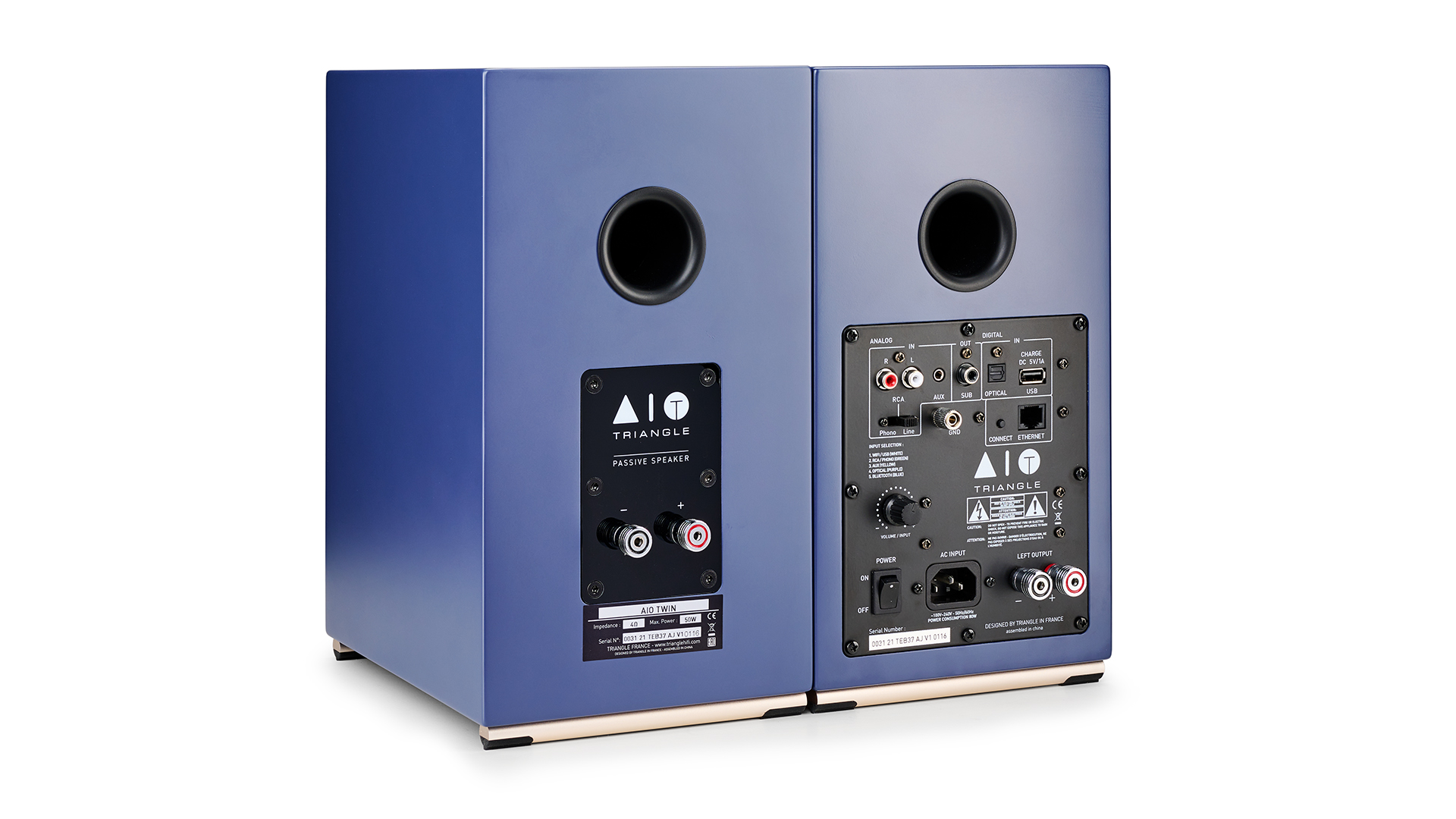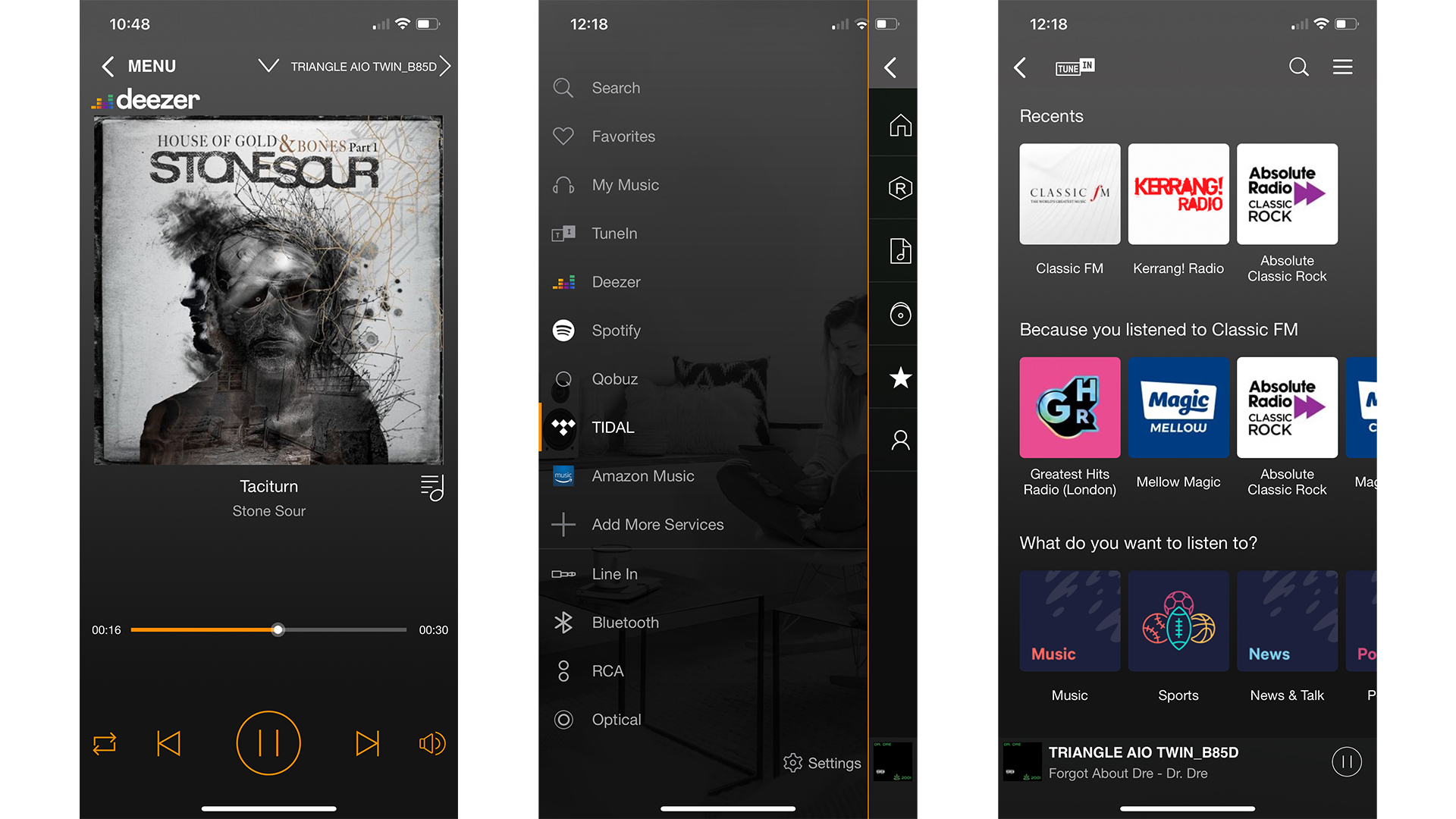What Hi-Fi? Verdict
We’ve not come across such an enthusiastic, talented all-in-one system at this price – highly recommended
Pros
- +
Enthusiastic and capable sound quality
- +
Elegant design
- +
Versatile features and connectivity
- +
Good app
Cons
- -
Built-in phono stage could be better
Why you can trust What Hi-Fi?
The Triangle AIO Twin is an all-in-one wireless speaker system akin to the superb KEF LSX II, but at half the price. That was more than enough to pique our interest: music systems that integrate all amplification, connectivity, streaming and more features into one box or a pair of speakers are an increasingly neat and attractive way to get hi-fi sound into your home.
Not only are they lifestyle-friendly (not everyone has space for so many separate boxes), but their feature set means you can play just about anything through them.
And that’s the case with the versatile Triangle AIO Twin: it may look like a pair of ‘normal’ speakers, but this a fully-fledged, versatile music system in its own right, with a whole host of features and a level of performance that makes for quite the bargain at this price point (£699 / $1000 / AU$1099).
Build & Design

We warmed to the Triangle system the second it was out of the box. The two speaker cabinets look smart and classy, and are an appealing size. They’re bigger than the dinky Ruark MR1 Mk2 desktop speakers, but they’re considerably smaller than the Q Acoustics M20 or your standard pair of bookshelf speakers.
This means you can be pretty flexible in where you place them, especially if you’re working with a small space. However, we wouldn’t place them too close up against a wall as they have rear-firing ports and need some space to breathe.

Power 2x 50W
Drivers 25mm tweeter; 13cm bass
Bluetooth Bluetooth 5.0, aptX, aptX HD, aptX LL, SBC, AAC
Streaming Wi-Fi, Internet Radio
Streaming services Spotify, Tidal, Qobuz, Deezer, Amazon Music, Napster
Resolution support Up to 24-bit/192kHz
Inputs Ethernet, RCA / Phono MM line level, 3.5mm, optical, USB-A
Output Subwoofer
App? Yes
Remote control? Yes
Dimensions (hwd) 23.5 x 16.5 x 30.4cm
Weight 10.3kg (total)
Finishes: 6
The build quality and finish are generally of a good standard. We like the subtly rounded corners and the fabric grille that matches the finish. Our review sample is a lovely shade called Abyss Blue, but you can also get the system in Frost White, Graphite Black, Brown Maple, Linen Grey and Eggplant (deep purple).
The aluminium feet with rubber pads that support the bottom of each speaker are a nice touch, designed to minimise vibrations and protect the surface you place the speakers on. One of the rubber ends on our sample came off easily and repeatedly during testing, so take care when you move the speakers.
Unlike active speakers which have amplification in both speakers powering each driver, the Triangle AIO Twin is a powered speaker system with a master/slave arrangement. This means the 50 watts of amplification, streaming module and connections are all housed in one “master” speaker, from which runs a wired connection to the second, passive speaker. Both speakers have a 25mm tweeter and a 13cm mid/bass driver.
Everything is neatly labelled, and we particularly like the colour key printed at the back of the right speaker for each connection. This corresponds to the bright LED on the front of the master speaker, which changes colour depending on which input or streaming option is being used to play music.
A slim remote control is included, which is easy to operate for volume and basic playback, although we prefer using the AIO app when streaming wirelessly.
Features

This Triangle system can play just about anything, from Bluetooth streams from your phone to music files stored on your home network to even, yes, your vinyl records. It can also be a soundbar alternative for your TV.
For your streaming needs, the AIO Twin has built-in wi-fi and Bluetooth 5.0 with support for high-res codecs such as aptX HD as well as basic SBC and AAC. An ethernet port is also included for a more stable connection to your home network.
All the major streaming services are supported – Spotify, Tidal, Deezer, Amazon Music, Qobuz – and you can also play internet radio using the excellent app. High-resolution audio support goes up to 24-bit/192kHz, which is good news for those with a considerable digital music library or subscription to a service’s hi-res tier.
Streaming is only half the story, though. The Triangle system also has a built-in phono stage, meaning you can directly plug in your (moving magnet only) turntable to the AIO Twin without the need for extra boxes. It’s a neat solution for those dipping their toes into vinyl.
Other physical connections include a digital optical input, an RCA analogue pair (there’s a switch to use this input as line level or MM phono), a 3.5mm aux input, USB-A for charging your phone, and a subwoofer output.

Thankfully, despite all the various things this Triangle system can do, setting it up is easy and straightforward. The Triangle AIO app is comprehensive, responsive and makes the set-up process, streaming and daily use a breeze. The only thing we would add to the wishlist is customisable EQ settings.
To add another string to the Triangle AIO Twin’s versatile bow, it can also be set up as a multi-room system with other AIO products – that could be another set of the Twin and/or the stylish four-star AIO 3 wireless speaker.
Sound

Given their size, you might be tempted to have the AIO Twin as just desktop speakers, but this system is so talented and capable that it deserves to be placed on dedicated stands.
This system is incredibly fun to listen to. It’s an enthusiastic performer, happy to tackle any music genre and recording quality, and simply wants you to enjoy the music being played.
But alongside that dose of fun, there is a mature sense of composure running through its veins that is really impressive.
Circling by Four Tet is a stern test of timing and dynamics, and the AIO Twin handles the song with a playful, agile touch that goes hand-in-hand with an admirable level of control, precision and subtlety. It organises the complicated strands of instruments and noises with a confidence that seems easy – that’s quite the skill.
While we aren’t expecting lashings of deep bass from such relatively compact speaker cabinets, we’re impressed with how taut, shapely and snappy basslines are. It moves the rhythm of a song forward, never lagging or sounding tubby. Run The Jewels’ Legend Has It is propelled forward with a strong sense of drive and attack, the duo’s distinct attitudes coming through clearly via the Triangle system.
It’s balanced across the frequencies: taut bass, clear voices and sparkling, clean treble that’s punchy but never bright.
Charlotte Lawrence’s vocals on Joke’s On You soar with emotion, her voice crystal clear in a pleasingly big and spacious soundfield. There’s ample power here too, giving a big power ballad plenty of welly when needed.
Whether you’re playing Tidal via wi-fi, Apple Music through Bluetooth or a CD player through optical, the Triangle system plays everything with cheery aplomb, inviting you to sing along to oft-played songs.
It’s only with the built-in phono stage does it falter. We paired the system up with the excellent, five-star Pro-Ject Debut Pro turntable. While the peppy character remains the same, it doesn’t sound as clear, precise or expressive compared with the other inputs. You can still sing along to the record, but the quality when streaming through wi-fi is far superior.
We’d say the AIO Twin system is a nice starting point if you’re just dipping your toes into vinyl, but if you’re serious about your record collection, we’d recommend going for a dedicated phono stage, which you can plug into the Triangle’s line-level input.
Verdict

Like the very best kit, we want to keep on listening to the Triangle AIO Twin. And that’s the best recommendation we can give to someone looking for a neat, elegant system that does it (nearly) all. If you’re looking for a fun music system that also sounds hugely capable in hi-fi terms, and that you don’t have to pay over a grand for, this system is worth your attention.
Review published: 2022. Review updated: November 2024.
SCORES
- Sound 5
- Build 4
- Features 5
MORE:
Read our review of the Q Acoustics M20
Also consider the excellent KEF LSX II
What Hi-Fi?, founded in 1976, is the world's leading independent guide to buying and owning hi-fi and home entertainment products. Our comprehensive tests help you buy the very best for your money, with our advice sections giving you step-by-step information on how to get even more from your music and movies. Everything is tested by our dedicated team of in-house reviewers in our custom-built test rooms in London, Reading and Bath. Our coveted five-star rating and Awards are recognised all over the world as the ultimate seal of approval, so you can buy with absolute confidence.
-
Combat I bought these a few months back and have been seriously impressed. I've cycled through quite a few active and passive speakers in the past five years and love the agile and sweet sound of these speakers. They aren't too bright and have a forward mid range. So much so that I have boosted the treble slightly in the eq settings despite having them only sitting a metre from me on my work desk.Reply
The critical addition that I made was to add the Rel T/Zero MKIII subwoofer. The combination is incredible!
I really can't see how the KEF LSX 2s would beat this Triangle + Subwoofer combination which works out as the same price. -
flyingdutchman Just bought the AIO Twin speakers. Using the Triangle app works but the app is very flakey and I want to use my own android music player Poweramp. I do not seem tobe able to stream over bluetooth using a different app.Reply
Can anyone confirm whether it is only the triangle app that works with these speakers? -
Combat Reply
I've not tried Bluetooth on it much but my understanding is that once you've connected the speakers to another device via Bluetooth then any thing that you play with sound on the other device will play through the speakers. It should matter what app.flyingdutchman said:Just bought the AIO Twin speakers. Using the Triangle app works but the app is very flakey and I want to use my own android music player Poweramp. I do not seem tobe able to stream over bluetooth using a different app.
Can anyone confirm whether it is only the triangle app that works with these speakers?
Poweramp brings back memories. I'm assuming you've got music stored on your phone?
I only really use the WiFi input via Spotify on my laptop or phone and it works perfectly. I do have to connect to the speakers via Spotify each morning because my laptop has been asleep but it's straight forward. -
flyingdutchman All sorted. I assumed that when you switch it on, it would be bluetooth mode. This was not the case, needed to select the correct input.Reply
I do not intend to use the triangle app. The music player is too limited, poor equaliser, returning to a list takes you back to the top so you have select again etc. -
Exiled Royal Can anybody give me a clue as to whether I can attach an SSD to the USB port at the back? It's formatted to NTFS currently. Or will it only read from a USB stick? Cheers.Reply -
rousp Reply
Hi,Combat said:I bought these a few months back and have been seriously impressed. I've cycled through quite a few active and passive speakers in the past five years and love the agile and sweet sound of these speakers. They aren't too bright and have a forward mid range. So much so that I have boosted the treble slightly in the eq settings despite having them only sitting a metre from me on my work desk.
The critical addition that I made was to add the Rel T/Zero MKIII subwoofer. The combination is incredible!
I really can't see how the KEF LSX 2s would beat this Triangle + Subwoofer combination which works out as the same price.
what are your settings on the Rel subwoofer please?


